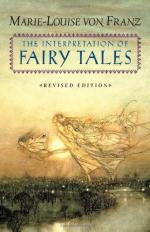
|
| Name: _________________________ | Period: ___________________ |
This test consists of 15 multiple choice questions and 5 short answer questions.
Multiple Choice Questions
1. According to Freudian psychology, what comprises the unorganized part of the personality structure that contains the basic drives?
(a) Ego.
(b) Super-ego.
(c) Self.
(d) Id.
2. Von Franz believes fairy tales originate as "local ___."
(a) Anecdotes.
(b) Myths.
(c) Religions.
(d) Sagas.
3. Which individual linked fairy tales to "elementary thoughts" and even "national thoughts," notions that might be precursors to Jung?
(a) Adolf Bastian.
(b) Kaarle Krohn.
(c) Ludwig Laister.
(d) Theodor Benfey.
4. What is the third thing the toad gives to Dummling in "The Three Feathers"?
(a) A carpet.
(b) A crown.
(c) A ring.
(d) A baby toad.
5. What is the title of the primordial waters of the cosmos, the mother from which the cosmos emerged in Egyptian mythology?
(a) Mut.
(b) Mumu.
(c) Ra.
(d) Ma.
6. What is the name given to processes whereby the undifferentiated tends to become individual, or to those processes through which differentiated components become integrated into stable wholes?
(a) Solitarization.
(b) Culmination.
(c) Self visualization.
(d) Individuation.
7. What philosopher wrote of stories that old women told their children, called mythoi?
(a) Plato.
(b) Aristotle.
(c) Socrates.
(d) Euripides.
8. What Finnish folklorist, professor and developer of the geographic-historic method of folklore research tried to find original versions by judging which tales were the best and most complete?
(a) Carl Jung.
(b) Kaarle Krohn.
(c) Theodor Benfey.
(d) E. Stuck.
9. At the end of the telling of a fairy tale, there is also often a "bringing back to" what, according to von Franz?
(a) Self.
(b) Id.
(c) The beginning.
(d) Reality.
10. What does the magical toad give to Dummling when they meet in "The Three Feathers"?
(a) A carpet.
(b) A princess.
(c) A ring.
(d) A goblet.
11. What term is typically used to refer to polytheistic religious traditions, although from a Christian perspective the term can encompass all non-Abrahamic religions?
(a) Neopaganism.
(b) Paganism.
(c) Nonsecularism.
(d) Pluralism.
12. According to Freudian psychology, what comprises that organized part of the personality structure that includes defensive, perceptual, intellectual-cognitive, and executive functions.?
(a) Ego.
(b) Super-ego.
(c) Self.
(d) Id.
13. Who is the protagonist of "The Three Feathers"?
(a) Ivan.
(b) Dummling.
(c) Dimeling.
(d) Dumeling.
14. According to the author, animals in fairy tales are anthropomorphized aspects of what?
(a) Ethnic relations.
(b) Human conditions.
(c) Cultural stimulus.
(d) Religious imagery.
15. What German brothers are important in the history of the fairy tale, as they collected, standardized, and then popularized European folk tales?
(a) Grimm.
(b) Morgan.
(c) Aesop.
(d) Bosley.
Short Answer Questions
1. What refers to feminine essence buried in the unconscious of every man in Jungian psychology?
2. What individual broke the Greek Hercules mythology down and discovered that the myth was made up of a succession of fairy tales?
3. Carl Jung is often considered the first modern psychologist to state that the human psyche is "by nature" what?
4. What refers to the masculine essence buried in the unconscious of every woman in Jungian psychology?
5. Marie-Louise von Franz bases much of her interpretation of psychology and fairy tales on whose theories?
|
This section contains 472 words (approx. 2 pages at 300 words per page) |

|




